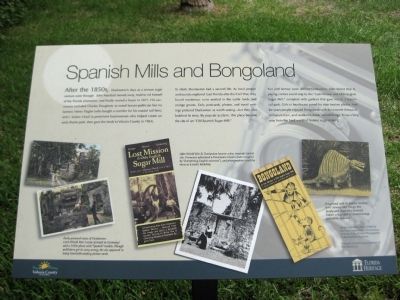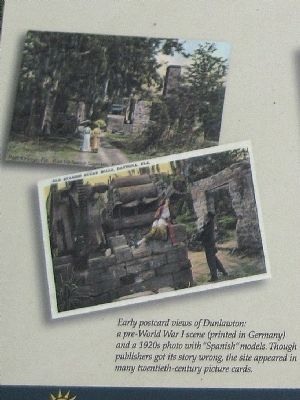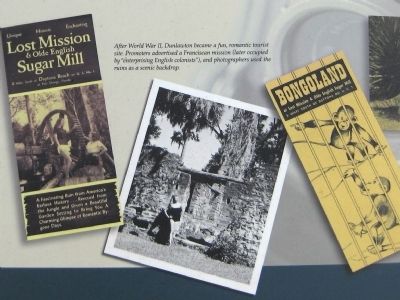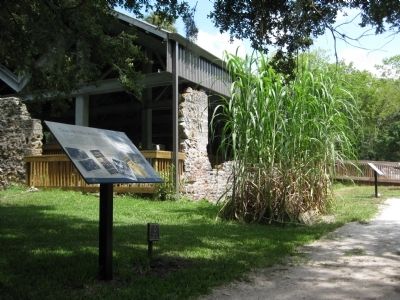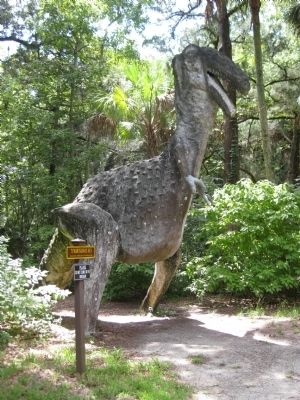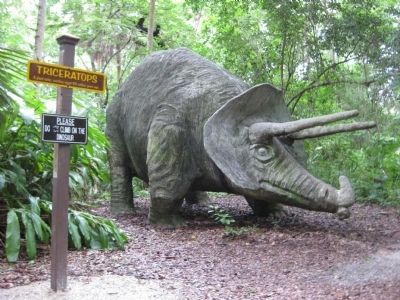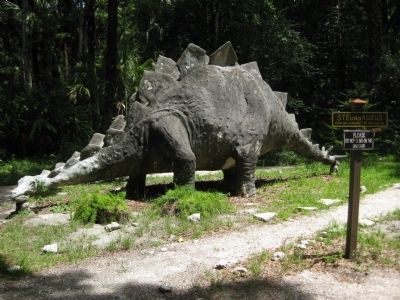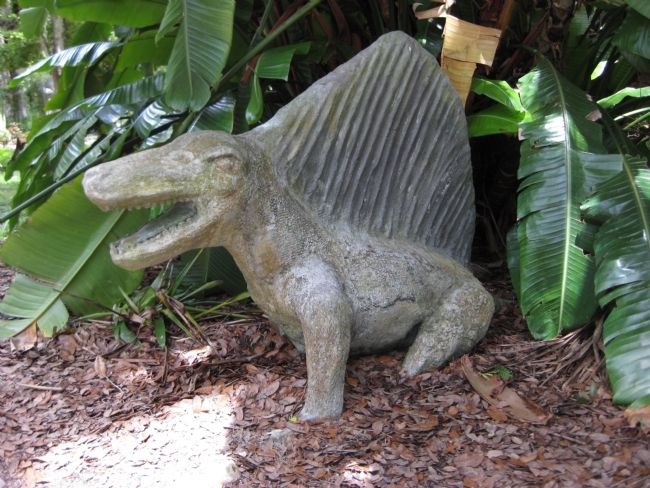Port Orange in Volusia County, Florida — The American South (South Atlantic)
Spanish Mills and Bongoland
In short, Dunlawton had a second life. As local people and tourists explored East Florida after the Civil War, they found mysterious ruins nestled in the cattle lands and orange groves. Early postcards, photos, and travel writings pictured Dunlawton as worth seeing - but they also botched its story. By popular acclaim, this place became the site of an "Old Spanish Sugar Mill."
Fun and fantasy soon defined Dunlawton. After World War II, paying visitors could stop by the "Lost Mission and Olde English Sugar Mill," complete with gardens that gave rise to a botanical park. Girls in beachwear posed for state tourism photos. And for years people enjoyed Bongoland, with its concrete dinosaurs, miniature train, and resident baboon named Bongo. It was a long way from the hard work of frontier sugar making.
[ Postcards ]
Early postcard views of Dunlawton: a pre-World War I scene (printed in Germany) and a 1920s photo with "Spanish" models. Though publishers got its story wrong, the site appeared in many twentieth-century picture cards.
[ Brochure cover; Photo ]
After World War II, Dunlawton became a fun, romantic tourist site. Promoters advertised a Franciscan mission (later occupied by "enterprising English colonists"), and photographers used the ruins as a scenic backdrop.
[ Brochure cover; Illustration ]
Bongoland, with its famous "monkey host." Among other things, this family park featured a Seminole Indian Village and "re-created strange prehistoric monsters."
Model-and-ruins photo (1946) by the State Department of Commerce, courtesy of the Florida Photographic Collection/State Archives.
Postcards and brochures courtesy of Tom Baskett, Jr.
Erected by Volusia County and the State of Florida, Department of State, Division of Historical Resources, assisted by the Florida Historical Commission.
Topics. This historical marker is listed in these topic lists: Animals • Entertainment • Industry & Commerce. A significant historical year for this entry is 1871.
Location. 29° 8.479′ N, 81° 0.355′ W. Marker is in Port Orange, Florida, in Volusia County. Marker can be reached from Old Sugar Mill Road east of Herbert Street, on the left when traveling east. The marker is on the grounds of the Dunlawton Sugar Mill Botanical Gardens. Touch for map. Marker is at or near this postal address: 950 Old Sugar Mill Road, Port Orange FL 32129, United States of America. Touch for directions.
Other nearby markers. At least 8 other markers are within walking distance of this marker. Dunlawton's Building Blocks (here, next to this marker); Emathla (King Philip) (a few steps from this marker); Living on the Edge (a few steps from this marker); Sugar Making (a few steps from this marker); The Dunlawton Sugar Factory (a few steps from this marker); Telling Dunlawton's Stories (a few steps from this marker); The Most Dangerous Chieftain (a few steps from this marker); From the Boardwalk (a few steps from this marker). Touch for a list and map of all markers in Port Orange.
More about this marker. The marker features the logos of Volusia County and the Florida Heritage program.
Regarding Spanish Mills and Bongoland. The site was listed with the National Register of Historic Places in 1973 under the name Dunlawton Plantation--Sugar Mill Ruins (# 73000606).
Related markers. Click here for a list of markers that are related to this marker. To better understand the story of the Dunlawton Plantation and Sugar Mill Ruins, study each marker in the order shown.
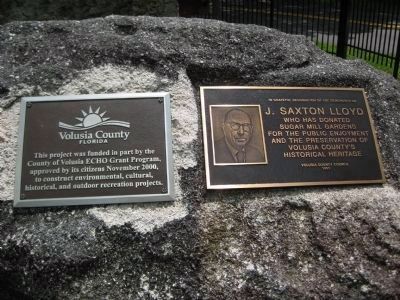
Photographed By AGS Media, August 13, 2010
9. Additional markers near the Dunlawton Sugar Mill Ruins
The first marker features the Volusia County logo and reads:This project was funded in part by the County of Volusia ECHO Grant Program, approved by its citizens November 2000, to construct environmental, cultural, historical, and outdoor recreation projects.
The second, featuring a portrait of its honoree, reads:In grateful recognition of the generosity of
J. Saxton Lloyd
who has donated Sugar Mill Gardens for the public enjoyment and the preservation of Volusia County's historical heritage
Volusia County Council
1983
The second, featuring a portrait of its honoree, reads:
J. Saxton Lloyd
who has donated Sugar Mill Gardens for the public enjoyment and the preservation of Volusia County's historical heritage
Volusia County Council
1983
Credits. This page was last revised on August 19, 2020. It was originally submitted on August 26, 2011, by Glenn Sheffield of Tampa, Florida. This page has been viewed 843 times since then and 19 times this year. Photos: 1. submitted on August 26, 2011, by Glenn Sheffield of Tampa, Florida. 2, 3, 4, 5, 6, 7, 8, 9. submitted on August 27, 2011, by Glenn Sheffield of Tampa, Florida. • Bill Pfingsten was the editor who published this page.
